In the bad old days of the sportsman-naturalist, times when any
bird which flew was fair game for the roving gunner and the rarer
the species, the more prized the trophy, there used to be a
saying "What's hit is history and what's missed is
mystery." Fortunately we have a more enlightened approach to
our sport today and the cardinal rule for fowlers is "Never
raise your gun until you have positively identified the bird as
legitimate quarry."
The problem facing all wildfowlers is that the run-of-the-mill
bird books have drawings or photographs of the duck and goose
species sitting obligingly on the water, presenting a nice
side-on view. When we are out on the marsh with dog and gun it is
more common for a grey shape to flip past our left shoulder in
the half-light of dawn or dusk.
Wildfowl identification under those conditions is a somewhat
different matter from leisurely admiring the duck on the village
pond on a sunny Sunday afternoon. Very often the plumage
colouring will be indiscernible and the fowler must rely upon
other "keys" to help him determine the species.
It takes a lot of experience before any shore shooter can
positively identify every duck or goose which he might encounter
but, before too long, he ought to be able to distinguish the
common quarry species from the common protected birds. The
descriptions which follow not only deal with the plumage
characteristics of the fowl which are most likely to be seen by
the longshore gunner, but also mention the more obvious
"keys" such as variations in wing beat speed, flashes
of light or dark colour, wing length to body length ratio and
differences in flight sound which the accomplished wildfowler
will recognise in that split second before the gun is raised. .
Mallard (Anas platyrhynchos)
The commonest and best known of all our duck, the mallard is a a
superb table bird, especially early in the season. The male has
an iridescent bottle-green head and neck, separated from its
chestnut breast by a narrow white neck ring. The underbody and
wing coverts are predominantly grey with the characteristic
white-edged, blue-purple speculum being a striking feature. Tail
coverts are black with the four central feathers upturned. A
greenish-yellow bill and orange legs complete the familiar
picture. The female mallard is a much less colourful bird of
mottled brown and paler underparts. Her bill is orange and the
legs are somewhat weaker in colour than those of the drake but
the iridescent speculum is common to both sexes. Juveniles and
the male in eclipse plumage are similar in general appearance to
the female. The mallard has a strong, fairly fast, level flight
with rapid wing beats. It is one of the largest duck. The drake
is normally silent in flight while the female emits the familiar
low "quack".
. |
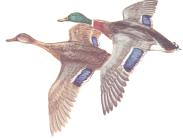 |
Wigeon (Anas penelope)
Many wildfowlers would suggest that the wigeon is the duck of the
estuary and there can be little doubt that a pack flighting
overhead, their characteristic whistle shrilling from a dark sky,
is guaranteed to set the blood racing through the veins of a
seasoned marsh gunner. Somewhat smaller than a mallard, the
wigeon is another duck which provides sporting shooting. The male in winter plumage has a chestnut head
with a pale yellow forehead and crown, a pinkish-grey breast and
mainly grey back and flanks. The white forewing coverts show
boldly in flight, as do the very light underparts. The female and
juvenile are predominantly rusty brown mottled with dark chestnut
and they share the lighter belly of the male. Both sexes have a
dark green speculum which is slightly less prominent than that of
most dabbling duck. In eclipse, the male takes on the general
coloration of the female but retains his white shoulder patches.
The short pointed bill is typically grey with a dark tip and the
legs are dark grey or black. The wigeon has a rapid flight with
the wings often appearing sickle-shaped. It is medium sized and
the short bill, light belly and the white shoulders of the male
show up clearly in flight. The male has a high pitched whistle
while the female has a lower purr.
. |
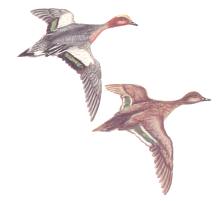 |
Teal (Anas crecca)
The European green-winged teal is the smallest duck on the
wildfowler's list but the male in full breeding plumage makes up
for his small size by his striking good looks. The glossy
chestnut head has an iridescent curving green stripe, with narrow
cream edging, running from the eye to the back of the neck. The
striated body plumage is well known to anglers who dress their
own flies and there is a white horizontal stripe above the wing.
The prominent green speculum is present in both sexes. The
female, juvenile and male in eclipse plumage are very similar
with their mottled browns and paler belly. The legs and bill of
both sexes are dark grey, tinged with brown. The teal has a very
rapid flight with small flocks frequently rising and dipping in
unison. The male has a "prip-prip" call whereas the
female "quacks" at a slightly higher pitch than a
mallard.
. |
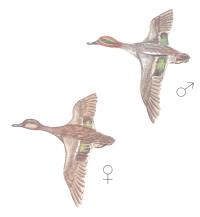 |
Garganey (Anas querquedula) (Protected)
The little garganey is the only duck which is exclusively a
summer visitor to Britain and, consequently, is not seen
frequently during the shooting season. Slightly larger than a
teal, the male in full plumage has a brown head and breast with a
sickle-shaped white band from above the eye to the nape of the
neck. The body is mottled grey-brown with paler sides and
black-edged white scapular feathers. The female, juvenile and
male in eclipse are largely grey-brown with darker mottling on
the wings. In both sexes the speculum is pale green and cream.
. |
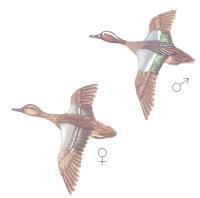 |
Pintail (Anas acuta)
The handsome pintail must be a strong contender for the
distinction of being Europe's most elegant wildfowl species. In
breeding plumage the male is resplendent in chocolate head and
neck with a white stripe extending upwards from breast to ear.
Grey underparts and flanks are set off by beautiful lanceolated
scapulars of black, yellow and grey and there is a pale yellow
patch in front of the distinctive black tail coverts. The female
shares the slender neck and body of the male but is generally a
light mottled chestnut with paler underparts. Juveniles are
similar to the female but males in eclipse are somewhat greyer
and may be distinguished by the bronze-green speculum on the
wing. Bill and legs are grey with a bluish tinge. The pintail has
a fast flight with very rapid wing beats. The male's
"pin" tail shows up prominently in flight but both
sexes are long, slender birds with slightly sickle-shaped wings.
The male has a lower pitched "prip" than the teal while
the female occasionally gives a rather weak mallard-like
"quack".
. |
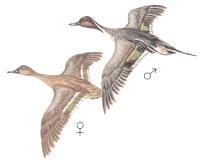 |
Shoveler (Anas clypeata)
A very distinctive bird, the shoveler displays the ultimate in
dabbling equipment - a very broad spatulate bill which gives an
immediate clue to the species' feeding habits. The drake in
breeding dress has a bottle-green head, white neck and chest,
dark chestnut flanks and underparts and dark brownish-grey wing
coverts. The colouring of the female is similar to that of other
dabbling duck but the shovel bill makes misidentification
unlikely. Both sexes have a green speculum and display a
blue-grey patch on the forewing. The shoveler has a rapid flight
with a rattling sound from the wings. It is medium size and the
light blue shoulders are prominent in flight. The large spatulate
bill often looks longer than the head and it rarely quacks while
flying.
. |
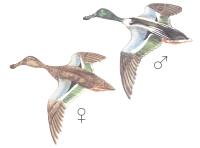 |
Gadwall (Anas strepera)
Difficult to distinguish from a mallard when flying in poor
light, the gadwall is slightly smaller but very similar in build
and in flight pattern. The drake is predominantly grey with a
brown tinged back. The female is very mallard-like but shares the
white speculum of the male. The bill of the female has
conspicuous orange edges which, although not present in the drake
when in breeding plumage, are taken on in eclipse.
. |
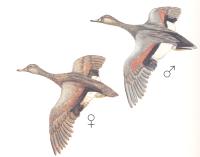 |
Tufted Duck (Aythya fuligula)
All of the species mentioned so far have been dabbling duck of
the genus Anas. With the tufted duck we come to the first member
of the diving duck genus Aythya which also includes the pochard
and the now-protected scaup. The "tuftie" is very
common on most waters in Britain and occurs both as a breeding
species and as a winter migrant. When in full breeding regalia
the male has a black head, chest, back and tail with pure white
flanks. The head is shot with purple and the chest often seems to
have a greenish tinge. The name of the duck derives from a
drooping black crest which is not normally obvious at a distance
but which, in fact, is fairly long. The bill is blue-grey with a
black tip, the legs are grey and the eye is bright orange. The
female's colouring is less contrasting than the male, her
upperparts being dark brown and the flanks pale rust. In eclipse
the male resembles the female but usually has lighter flanks.
Both the male in eclipse and the female have a shorter crest than
the breeding male. The tufted duck has a more fluttery flight
than the dabbling duck, it is of small to medium size and the
male's colour contrast is sometimes fairly clear. It rarely
quacks in flight.
. |
 |
Pochard (Aythya ferina)
In full breeding plumage the male pochard is a striking bird
displaying a red-brown head, black breast and throat and a
slate-grey back. The bill is blue-grey with a black tip and the
legs are dark grey. In eclipse the red eye of the male
distinguishes it from the dull brown female. The pochard has a
strong, fast flight. It is of medium size and the male has a low
whistle while the female occasionally gives out a deep-throated
"kurr".
. |
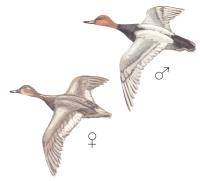 |
Scaup (Aythya marila) (Protected)
Closely related to the tufted duck, the scaup may easily be
misidentified by a wildfowler. In breeding plumage the male has a
black head, shot with green, a black breast, light grey wings and
white flanks and belly. The female is predominantly brown with
paler flanks and underparts. Unlike the tufted duck, the scaup is
found mainly in sea areas and rarely will be encountered on
inland waters.
. |
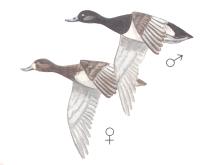 |
Goldeneye (Bucephala clangula)
The mature male goldeneye has an iridescent green head with a
prominent white patch between bill and eye. Its back is black and
the neck and underparts white or pale grey. The female has a
mainly grey body with a chestnut brown head. As the name suggest,
the eyes are golden yellow and the short bill and sloping
forehead give the head a triangular look. The flight of the
goldeneye is rapid and direct with a noticeable wing rattle. The
light underparts show up in flight.
. |
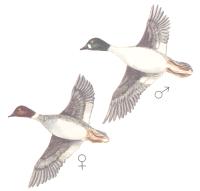 |
Shelduck (Tadorna tadorna) (Protected)
In some localities the shelduck is so numerous that one might
wonder why it requires to be protected by law. Fortunately it is
so distinctive in appearance that there is never any excuse for
mistaking it for any other bird. Both sexes have a black neck and
head, a white body and a rich brown yoke at shoulder level. There
is a dark stripe down the underparts and the wing primaries are
black. The male may be distinguished by the knob at the base of
its bright red bill. The shelduck has a strong goose-like flight.
It is large in size and its contrasting markings are usually
visible, even when flying in poor light. The male occasionally
whistles and the female has a short, low "quack". |
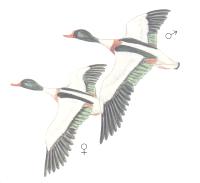 |
|

